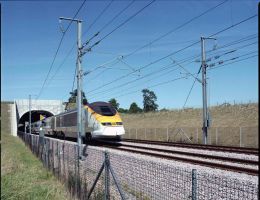Posted 30th September 2008 | 2 Comments
UK ‘left behind’ in high speed rail future, warns Euro-MP

Britain’s first high speed line – HS1 – should be first stage of a revolution, the meeting was told
THE vision that created Britain’s railways is now desperately needed to build new high speed rail lines, a meeting at the Liberal Democrat conference heard.
Paul Martin, director of the Railway Forum, told a fringe meeting at the Bournemouth conference that high speed rail would be a green way of tackling the network’s looming capacity crisis as there would be a shift from aviation.
He warned that key parts of inter-city routes would become saturated: “If we want to avoid a situation in 2030 when our railway network cannot cope with the demands placed on it, we need to start planning now.
“Let High Speed 1 be the first stage of the revolution and start planning now for High Speed 2 and beyond.
“We desperately need a vision, a vision that created our networks in the first place, and I am delighted the Liberal Democrats are showing the vision that is slightly lacking in the Government.”
North West Lib Dem Euro-MP Chris Davies chaired the meeting, saying he came from the region that “opened the world’s first inter-city railway in 1830 between Liverpool and Manchester.
“I look at our 68 miles of high speed line – we are being left behind and I find it deeply distressing.”
Civil engineer Colin Elliff told the meeting that high speed lines needed city centre termini rather than parkway stations on the edges of towns, to prevent causing environmental damage, and that Euston is perfect for London’s station.
Ultimately, high speed lines should link the Channel Tunnel and the continent with London, Birmingham, Manchester, Liverpool, Newcastle, Edinburgh and Glasgow, with further phases to include Plymouth, Cardiff and Aberdeen.
The improved connectivity would provide regeneration benefits and address the economic ‘tilt’ of the UK to the South East, he added.
But transport journalist Christian Wolmar told the event that there was no obvious route for a high speed line, unlike in France where it linked Paris and Lyons, the two biggest cities.
He said France, like Italy and Germany, was a much bigger country, but Britain’s two biggest cities, London and Birmingham, are barely 100 miles apart.
“We do not need a high speed line between them. This is an idea without a purpose – because other people have got it, we must have it.”
Wolmar said it would not be environmentally friendly, as “considerable demolition” would be required: “There is no easy route into London, Birmingham or Manchester.”
And he noted that in France and Spain they had been prepared to fund high speed lines, and run them at cheap prices by a largely nationalised network “to ensure people use the lines, rather than maximise the profit.”
But he claimed “in Britain we do not do things like that a privatised rail industry will not deliver high speed rail”.
Wolmar suggested it would be better to spend the huge sums involved on “modernising and simplifying the existing network”.
And he concluded: “I think this is a branch line down which we should not go, as it will lead us straight into the buffers.”
Reader Comments:
Views expressed in submitted comments are that of the author, and not necessarily shared by Railnews.

Jeremy, Chippenham, UK
I also think that the benefit in terms of a boost to morale that high speed rail would have to the rail industry and the travelling public should not be underestimated; High Speed 1 was the first positive press for railways in a long time and has spawned alot of interest in this discussion.
Modernising the existing network is arguably much more complex and expensive that building new lines, delivers less benefits, and all the public notice is the disruption required to make it happen. Look at the WCML for example, I bet by now HS1 probably cost less per mile.
As for the network, the Heathrow loop could easily extend to Wales (across the Severn Barrage?) and split off to serve the South West. Imagine being able to reach most big cities in the UK in a couple of hours from London without destroying the environment in the process.
John Jefkins, Croydon
Wolmar forgets that TGV France makes 10% profit each year AFTER having paid track access fees. TGV repaid construction costs within 15 years and makes a profit!
There IS an easy route out of London - via Willesden and West Ruislip and up the M40 (with a loop to Heathrow using existing lines to Willesden and new track up the M25 to the M40).
Getting via Birmingham and Manchester aiports to just north of Preston at 200mph is enoughtto get Scotland under 3hrs on existing track for the rest - and win the Scottish air market.
Get to Leeds via a Tamworth/Derby/Doncaster spur.
Such a Y shaped line relieves all major lines at once.